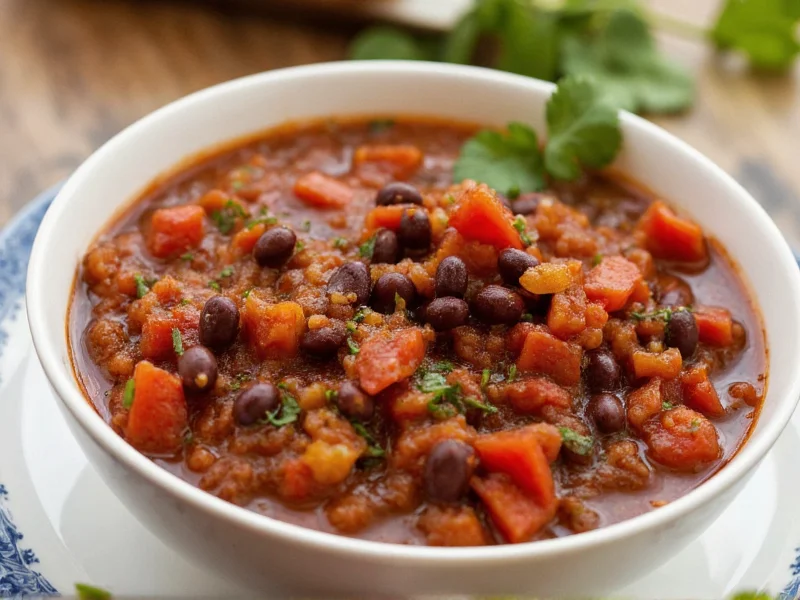Originating from Caribbean and Latin American culinary traditions, black bean sofrito transforms simple ingredients into a powerhouse of flavor. This preparation method builds upon the classic sofrito technique but incorporates cooked black beans to create a thicker, more substantial base that can be used immediately in various dishes. The magic happens when onions, bell peppers, garlic, and tomatoes meld with slow-simmered black beans, creating a deeply savory foundation that forms the heart of many traditional recipes.
The Cultural Significance of Black Bean Sofrito
While sofrito variations exist across Mediterranean and Latin cultures, black bean sofrito particularly shines in Cuban, Puerto Rican, and Dominican cooking traditions. In these cultures, black beans aren't just a side dish—they're culinary currency. The addition of beans to the sofrito base represents a practical evolution of the technique, combining two essential cooking elements into one time-saving preparation.
Traditional Cuban cuisine often features black bean sofrito as the foundation for "moros y cristianos" (black beans and rice), while Puerto Rican cooks might use it as a base for stews or as a flavor booster for plantain dishes. This preparation method demonstrates the resourcefulness of Latin American cooking, where nothing goes to waste and flavors build upon each other through careful layering.
Essential Ingredients and Their Purpose
The beauty of black bean sofrito lies in its simplicity and the intentional role each ingredient plays. Unlike regular sofrito which serves primarily as an aromatic base, black bean sofrito incorporates the beans themselves, creating a more substantial foundation.
| Ingredient | Traditional Amount | Flavor Contribution | Substitution Options |
|---|---|---|---|
| Cooked black beans | 2 cups | Earthy base, protein richness | Pinto beans (different flavor profile) |
| Yellow onion | 1 medium, finely diced | Sweetness, aromatic foundation | White onion (sharper), red onion (sweeter) |
| Bell pepper | 1 medium, finely diced | Vegetal sweetness, complexity | 1/2 cup diced green peppers |
| Garlic | 4-5 cloves, minced | Pungent depth, savory notes | 1 tsp garlic powder (less ideal) |
| Tomato | 1 medium, seeded and diced | Acidity, brightness | 2 tbsp tomato paste |
Step-by-Step Preparation Guide
Creating authentic black bean sofrito requires attention to technique rather than complexity. The key difference from regular sofrito is incorporating already-cooked beans into the aromatic base, allowing flavors to meld during a longer simmering process.
- Prepare your base: Heat 2 tablespoons of olive oil in a heavy-bottomed pot over medium heat. Add diced onions and bell peppers, cooking until softened but not browned (about 8-10 minutes).
- Add aromatics: Stir in minced garlic and cook for 1 minute until fragrant, being careful not to burn.
- Incorporate tomatoes: Add diced tomatoes and cook until they break down and the mixture thickens slightly (5-7 minutes).
- Add black beans: Stir in cooked black beans with about 1/2 cup of their cooking liquid. The liquid helps create the right consistency.
- Season and simmer: Add 1 teaspoon cumin, 1/2 teaspoon oregano, and salt to taste. Reduce heat to low and simmer uncovered for 20-25 minutes, stirring occasionally, until the mixture thickens and flavors meld.
- Final texture: For traditional texture, leave mostly intact. For smoother sofrito, use an immersion blender to partially puree while maintaining some bean texture.
Practical Applications in Everyday Cooking
Black bean sofrito shines as a flavor accelerator in numerous dishes. Unlike regular sofrito which requires additional cooking time, this bean-based version can be incorporated directly into finished dishes:
- Rice dishes: Stir 1/2 cup into 2 cups of cooked rice for instant "moros y cristianos"
- Bean preparations: Use as a flavor base when making additional black bean dishes
- Soups and stews: Add 1/4-1/2 cup to enhance vegetable or meat-based soups
- Breakfast applications: Mix with scrambled eggs or fold into breakfast potatoes
- Vegetable boost: Stir into roasted or steamed vegetables for added depth
Storage and Preservation Techniques
One of black bean sofrito's greatest advantages is its freezer-friendly nature. Properly stored, it becomes a kitchen staple that transforms simple ingredients into flavorful meals with minimal effort.
For refrigeration, store in an airtight container for up to 5 days. The flavors actually improve after 24 hours as the ingredients continue to meld. For longer storage, portion the sofrito into ice cube trays, freeze completely, then transfer the cubes to freezer bags. These portions (typically 2-3 tablespoons each) can be added directly to dishes as needed and maintain quality for up to 6 months.
When reheating, add a small amount of water or broth if the sofrito has thickened too much during storage. Gentle reheating over low heat preserves the delicate flavor balance better than high-temperature methods.
Regional Variations Worth Exploring
While the Cuban version remains the most widely recognized, regional adaptations offer exciting flavor variations worth exploring. In Puerto Rico, cooks often add culantro and a touch of vinegar for brightness. Dominican preparations might include a small amount of habanero for subtle heat. Some Venezuelan versions incorporate roasted red peppers for added sweetness.
For a healthier adaptation, try using avocado oil instead of olive oil and reducing the salt while increasing herbs. The authentic preparation, however, relies on the careful balance of traditional ingredients without substitutions that alter the fundamental character of the dish.
Troubleshooting Common Preparation Issues
Even experienced cooks encounter challenges with black bean sofrito. Understanding these common issues ensures consistent results:
- Too watery: Simmer uncovered for additional 5-10 minutes to reduce liquid
- Too thick: Add small amounts of bean cooking liquid or water while reheating
- Bland flavor: Balance with small increments of salt and acid (lime juice or vinegar)
- Burnt bottom: Start with lower heat and stir more frequently during initial cooking
- Overpowering garlic: Next time, add garlic later in the cooking process











 浙公网安备
33010002000092号
浙公网安备
33010002000092号 浙B2-20120091-4
浙B2-20120091-4